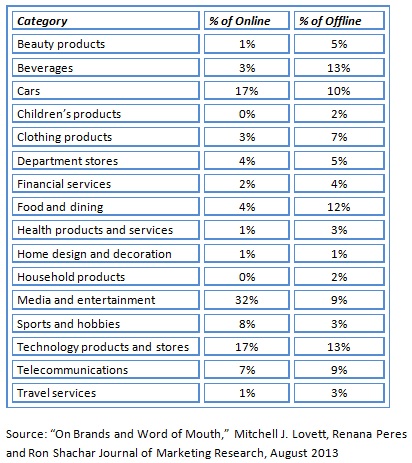Online vs. Offline Word of Mouth: Important Differences Revealed in Newly Published Academic Study - Ed Keller

It has been well documented by now that word of mouth and social media are significant forces in the consumer marketplace. Word of mouth is the most trusted source of information for consumers around the world according to Nielsen, and there is now measurable proof that social voice drives product sales both directly and indirectly. Further, we at Keller Fay have produced research that continues to surprise people: While many assume the rising power of word of mouth is linked to the rise of social media, only 10% of conversations about products, services and brands take place online while 90% still occurs offline -- at home, work, or when gathering in social settings of various sorts
A new academic study provides the most comprehensive analysis ever undertaken of the consumer motivations and brand characteristics that lead people to talk online and offline and reveals significant differences between the two. According to the research, "Online data does not reflect well the offline behavior. Word of mouth is not channel neutral. One cannot automatically generalize the results from online to offline." This suggests it is critically important for marketers to understand when digital strategies for motivating word of mouth are appropriate and likely to be effective, and when offline strategies are most appropriate.
The paper, "On Brands and Word of Mouth" appears in the August 2013 issue of the Journal of Marketing Research. The authors -- Professors Mitch Lovett of the Simon School of Business at the University of Rochester, Renana Peres of School of Business Administration at the Hebrew University of Jerusalem, Ron Shachar who is Dean of the Arison School of Business at Israel's Interdisciplinary Center Herzliya -- assembled a very large set of data including online word of mouth (provided by NM Incite), offline word of mouth (provided by the Keller Fay Group), brand equity (provided by Y&R's Brand Asset Valuator), and custom research on brands (conducted by Decipher). More than 600 of the most talked about brands in the US were analyzed, spanning 16 product categories, covering the period from 2007 – 2010. So this is a very comprehensive and robust research undertaking.
The study is rich in its insights, and there are two significant sets of findings that I wish to share.
Choosing Where to Talk: Different Motivations for Online vs. Offline Conversations
"Consumers spread the word on brands for three fundamental purposes," according to the academic research:
· Functional: "the motive to provide and supply information"
· Social: "the motive to send social signals to the environment [such as expressing uniqueness, self-enhancement, and a desire to socialize or belong]"
· Emotional: "the motive to share positive or negative feelings about brands in order to express these emotions or balance emotional arousal."
The primary drivers of online word of mouth, the authors find, are (in order): social, functional, and emotional. The primary drivers of offline word of mouth are the exact opposite: emotional, functional and social. "Offline conversations, which are mostly in one-on-one settings, are more personal and intimate by nature and thus allow people to share emotions such as excitement and satisfaction. Online WOM, which usually involves 'broadcasting' to many people (e.g. twitter), is more appropriate for social signaling (e.g., uniqueness)."
These results about the motives associated with WOM via different channels may explain another significant set of findings : the brand categories talked about online vary widely from those talked about offline. Media, autos and technology dominate online – all three carrying with them significant social currency in terms of what's new, interesting, and worth sharing with others if your goal is to show that one is "in the know." In fact, two thirds of all online conversation is about these three categories.
Meanwhile, numerous other categories are heavily underrepresented in online venues relative to offline. And yet the value of recommendations in those categories, which come primarily offline, is every bit as important and related to business success. The conversations people have offline are more diverse, less concentrated.
Category Distribution of Offline and Online Word of Mouth

What does this research mean in practical terms? It means that marketers can't choose a social strategy without first understanding the motivations of consumers to share. Online social media will be most effective if you have a new product or a new message for which social currency will be gained by sharing. But if you are seeking to tap the emotions that come with strong brand satisfaction and excitement that comes as a result of a recent purchase or exposure to an advertisement, then look for ways to help consumer share those stories offline where they will have their best chance for success.
Offline and online: These are two different channels, requiring different marketing strategies. They are not mirrors of each other, and by no means redundant. Marketers who are searching for the best way to unleash consumer conversation about products, services, and brands, need to take a holistic view and create strategies that are appropriate to the drivers of brand WOM, both those that are expressed online and those that take place offline.
Ed Keller, CEO of the Keller Fay Group, has been called "one of the most recognized names in word of mouth." His new book, The Face-to-Face Book: Why Real Relationships Rule in a Digital Marketplace, was recently published by Free Press/Simon & Schuster. You can follow Ed Keller on Twitter, Facebook and Google+, or contact him directly at ekeller@kellerfay.com.
was recently published by Free Press/Simon & Schuster. You can follow Ed Keller on Twitter, Facebook and Google+, or contact him directly at ekeller@kellerfay.com.
Read all Ed’s MediaBizBloggers commentaries at WOM Matters.
Check us out on Facebook at MediaBizBloggers.com
Follow our Twitter updates @MediaBizBlogger
The opinions and points of view expressed in this commentary are exclusively the views of the author and do not necessarily represent the views of MediaBizBloggers.com management or associated bloggers. MediaBizBloggers is an open thought leadership platform and readers may share their comments and opinions in response to all commentaries.


